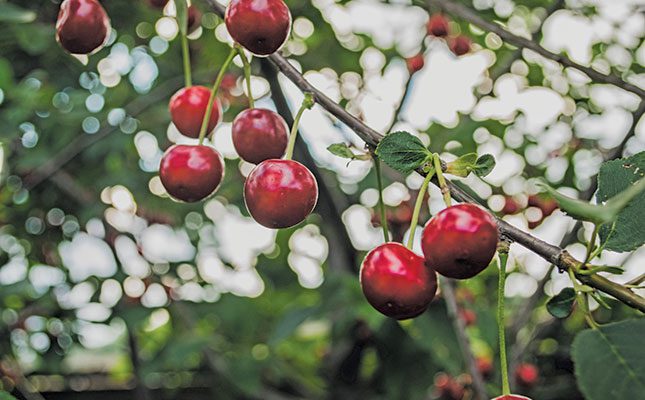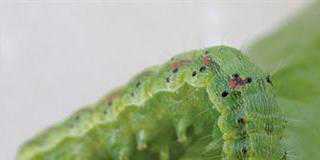
Photo: Pxhere
Cherry leaf spot (CLS), caused by Passalora circumscissa, is a fungal disease that can result in decreased fruit quality and yield due to inconsistent ripening or premature defoliation. However, there is limited information available in China about the resistance of cherry cultivars to leaf spot caused by P. circumscissa. Our study aimed to identify the resistance levels of cherry cultivars to this disease.
Fifty-two cherry cultivars, comprising 40 sweet cherry (Prunus avium), four Chinese cherry (P. pseudocerasus) and eight sour cherry (P. cerasus) cultivars, were evaluated for resistance level characterisation. Specimens of these cultivars were collected and then used to screen for P. circumscissa resistance through both detached leaf assays and natural field infection.
Our study provides a theoretical basis for cherry disease resistance breeding and rational cultivar utilisation.
Background
Cherry production in China has risen significantly over the past decade. China now has both the largest total sweet cherry cultivation area (200 000ha) and the greatest annual sweet cherry yield (about one million tons) in the world.
These increases have coincided with the rising prevalence of cherry foliar diseases in many regions of China. Leaf spot caused by P. circumscissa has emerged as a disease in cherry trees, posing a threat to sweet and sour cherry production in China. P. circumscissa primarily affects the leaves of cherry trees, resulting in early chlorosis and premature defoliation during summer.
This defoliation results in the trees being more susceptible to cold-induced injury and death during winter, and also results in major reductions (about 40%) in fruit yield and fruit quality.
Chemical control strategies are generally the most effective means of preventing this pathogen, but such efforts are often contraindicated because of their environmental impact and tendency to drive the development of fungicide resistance.
Resistant cultivars
An appealing alternative to the chemical control strategy is the identification of cherry cultivars that are resistant to foliar disease, thereby protecting cherry yields in a cost-effective and environmentally friendly manner. Effective screening strategies are therefore needed to identify CLS-tolerant or -resistant germplasm resources.
Currently, however, little information is available with regard to cherry cultivars that are resistant to CLS caused by P. circumscissa.
Although not currently considered a yield-limiting factor in most areas of the world, P. circumscissa leaf spot disease on cherry trees in some cultivation areas in China is of increasing concern, and is associated with a field incidence as high as 90%.
In our study, we used multiple approaches to evaluate commercial cherry cultivars to screen for P. circumscissa resistance.
The 52 cherry cultivars were planted during the spring of 2011 at an experimental station at the Shandong Institute of Pomology, Taian in Shandong Province, China. The cultivars were grafted onto Gisela 148-1, with trees in the orchard being planted in a 2m × 4m spacing scheme. No fungicides were applied to these trees, but all other standard recommended orchard, pest and weed management strategies were followed.
Cherry leaves with typical leaf spot symptoms were collected and transported to the laboratory. An improved single-spore isolation method was conducted. Inoculations were then performed using mycelial fragment suspensions.
To assess the resistance of detached leaves from different cherry cultivars to P. circumscissa CLS, leaves of similar size and age from all cultivars were collected in June from the test orchard. Leaves were inoculated using a mist sprayer to apply the mycelial fragment suspension to the entire surface of each leaf.
Five healthy, uniformly shaped mature leaves from each cherry cultivar were used for another inoculation assay. Leaf inoculation was conducted by adding 5μℓ of the mycelial fragment suspension to each site of infection on the upper leaf surface.
Leaves were sprayed twice daily with sterile distilled water to ensure that humid conditions were maintained. Inoculation was conducted at three sites per leaf, whereas a fourth site was inoculated with sterile distilled water as a control.
The rainy season in Tainan extends from June to October. Under these conditions, P. circumscissa CLS symptoms typically first appear during late June before peaking in late July to mid-August. We evaluated all trees for P. circumscissa CLS resistance during late August from 2013 to 2015, because disease symptoms were fully developed at this time. In total, we collected 200 randomly selected leaves from each cultivar to assess infected leaf areas.
Disease rating
To gauge disease severity, symptoms were scored via visual inspection based on the approximate leaf area containing lesions: 0 (no symptoms); 1, (0,1% to 10%); 3 (10,1% to 20%); 5 (20,1% to 30%); 7 (30,1% to 50%); 9 (50,1% to 100%). Rating scores were then used to calculate disease index (DI) values as follows:
DI = score × number of leaves with that score/total number of leaves × the highest score × 100.
DI values were then used to separate the cherry cultivars into the following resistance categories: immune (DI = 0); highly resistant (DI = 0,1 to 5); resistant (DI = 5,1 to 15); moderately resistant (DI = 15,1 to 25); susceptible (DI = 25,1 to 35); and highly susceptible (DI = 35,1 to 65).
Field observation
We observed significant differences between the 52 cherry cultivars with regard to their CLS resistance in field experiments. Average DI values for the cultivars ranged from 6,5 to 53,2 across the three-year study, indicating that none was immune or highly resistant to this disease.
Eighteen of the 52 accessions were resistant (average DI, 10,88), whereas 16 were moderately resistant (average DI, 19,63). Ten accessions and eight accessions were classified as susceptible and highly susceptible (average DIs, 28,54 and 42,25 respectively). These resistance levels accounted for 35%, 31%, 19% and 15% of total cultivars respectively.
We also found that correlations between field observation study results and detached leaf assay results were strong (0,59 to 0,70). An even stronger correlation was observed when comparing detached leaf assay results with the results from the average of all three years of field observation, confirming that true resistance to infection could be observed under field conditions over several years.
Strong positive correlations between these two assays suggest that these approaches can be used reliably to screen for CLS resistance.
Source: Yan Sung et al. 2022. ‘Assessment of Cherry Cultivars for Resistance to Leaf Spot Caused by Passalora circumscissa’. American Society for Horticultural Science. HortScience. 57(5).










